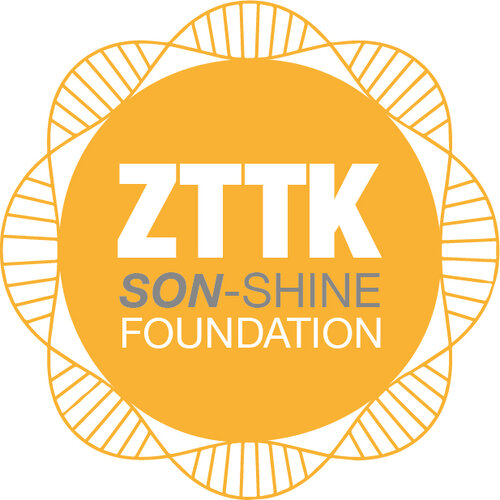Common Clinical Features of ZTTK Syndrome
Below are lists of common clinical features that make up the phenotype (characteristics) of ZTTK Syndrome:
It is important to remember that while this list of ZTTK Syndrome features are commonly reported among patients, it does not mean that your child will have all of the symptoms listed or have all of the body systems listed impacted by the syndrome. It is also important to remember that this is not an exhaustive list, so it is possible for a ZTTK patient to have additional symptoms or complications not listed here.
Cardiology: Aberrant Aorta; bilateral SVC; patent ductus arteriosus; ventricular and atrial septal defects; arrhythmias; hypoplastic left heart syndrome; coarctation of the aorta; heart murmur; transposition of great arteries; double-outlet right ventricle; mitral stenosis; tachycardia; high blood pressure; Tetralogy of Fallot; cardiomyopathy
Cleft and Craniofacial: submucous cleft palate; laryngeal clefts; facial asymmetry; deep-set eyes; low-set ears; midface retraction
Dermatology: eczema; dermatitis; sensitivity to sunlight; frequent staph infections; keratosis pilaris; Mast Cell Activation Syndrome; epidermolysis bullosa; hypohidrotic ectodermal dysplasia; hypohidrosis; dysplastic or missing fingernails; alopecia; severe reactions to bug bites; poor to slow healing of skin lesions/ burns/ injury
Ear, Nose, and Throat: severe and repeated ear infections; ear anatomical anomalies requiring multiple sets or permanent ear tubes to promote hearing and proper ear drainage; laryngomalacia; born without breathe/ suck/ swallow reflex; aspiration issues; poor swallowing; hearing loss; hypersalivation; epiglottal webbing; frequent nose bleeds; sleep apnea;
Endocrinology: Early onset and delayed puberty; adrenal insufficiency; thyroid disease; severe and rapidly decelerating hypoglycemia, which can result in unconsciousness; impaired function in glycolysis cycle; low cortisol; growth hormone deficiency; poor growth; short stature; carnitine deficiency; metabolic issues
Gastroenterology: poor growth and slow weight gain; GERD; gastric dysmotility; often present need for feeding tube; bacterial overgrowth of the small bowel; gastroparesis; pancreatic insufficiency; poor appetite; sensitivity to foods and formulas; nausea and vomiting; dysphagia; failure to thrive that can be persistent and/ or to such an extreme that can potentially lead to starvation/ catabolic state that cannot be reversed despite medical intervention, which has been fatal for a few ZTTK patients
Hematology: large red blood cells; abnormal CBC counts, including high and low WBC/ RBC/ Neutrophils; abnormally high B12, Vitamin A & E levels in the absence of vitamin supplementation; blood clots, including stroke; polycythemia; anemia requiring blood transfusions; low platelet counts requiring transfusions
Immunology: low or poor response to vaccines, low immunoglobulin levels, including IgG, IgA, and IgM; immune deficiency requiring immunoglobulin therapy, including Common Variable Immune Deficiency (CVID) and Autoimmune Encephalitis; presentation of frequent respiratory infections, severe allergies, and severe reactions to common illnesses, such as strep are common in ZTTK patients
Neurology: congenital brain abnormalities, including white matter loss, thinning/ partial/ total agenesis of the corpus callosum, thin optic nerves, etc.; epilepsy, including latent onset most often between the ages of 3 and 8 years old; intellectual and developmental delays that range from mild to severe; language delays that range from late onset, limited speech, and non-verbal; delayed developmental milestones; presentation of behaviors similar to Autism Spectrum Disorders, Bipolar, ADD/ ADHD, and Anxiety; hemiplegic migraines; auditory hallucinations; various forms of craniosynostosis; periventricular leukomalacia; periventricular heterotopia (PVNH); sudden onset of severe hydrocephalus resulting in cardiac arrest and tonsillar herniationof the brain, which has also proven fatal
Ophthalmology: Cortical Visual Impairment (CVI); intermittent exotropia; strabismus; nystagmus; near and farsighted requiring prescription eyeglasses/ bifocals from an early age; corrective surgery for eye muscle weakness often necessary; vision loss
Orthopedics/ Physical Medicine: scoliosis; kyphosis; extra bones; hypermobile joints; hypertonia; hypotonia; may require equipment for mobility and independence in mobility, such as walkers, gait trainers, AFO/ SMO/ insoles, weighted vests, etc.; osteoporosis; sacral dimple with and without tethered spinal cord
Pulmonology: Frequent respiratory infections; severe and prolonged respiratory reactions and infections to common illnesses, such as the common cold; respiratory distress syndrome at birth requiring intubation and surfactant; need for respiratory support for poor airway function, airway clearance, and weak cough, including cough assist, rescue inhalers, nebulizer treatments, chest PT, and suction; lung scarring due to repeated respiratory infections and aspiration; asthma
Therapy: Occupational, Physical, Vision, Speech, Developmental, and Behavioral Therapies are often necessary
Urology: Ureter reflux, both bilateral and unilateral, ranging from mild to severe; kidney scarring and damage due to repeated infections due to urological abnormalities; severe urinary tract infections including pyelonephritis; frequent urinary tract infections requiring prophylactic antibiotic treatment; horseshoe kidney; kidney atrophy; cystic kidneys; hydronephrosis; dysplastic kidney
ZTTK Syndrome affects patients across a spectrum. Some patients are more severely affected by the syndrome than others. Current research indicates that the location of the mutation on the SON gene plays a significant role in the severity of the syndrome. It is also important to remember that even though ZTTK Syndrome is new and rare, the common clinical features listed above are overwhelmingly well-known to the medical community. So, while there is currently no overall treatment or cure for ZTTK, the medical complexities associated with the syndrome can be managed individually.
Stay tuned for a Diagnostic Manual for ZTTK Syndrome to be published on the website in the near future! We hope that this manual will make the lives of patients and their medical teams easier as it will provide diagnostic guidance, including a suggested list of specialists, tests, and common treatments for the medical complexities of the syndrome.
Less Common Features of ZTTK Syndrome
There are other features of ZTTK Syndrome that have been reported in patients and in literature that are less common but still notable. Again, please remember, that your ZTTK patient may or many not experience the features of ZTTK Syndrome, common or uncommon, in their entirety.
Brain Tumors
Bone Marrow Failure
Bone Marrow Hypocellularity
Shortened Telomeres
Polycythemia Vera
Aplastic Anemia
Thalassemia
Intestinal Failure



